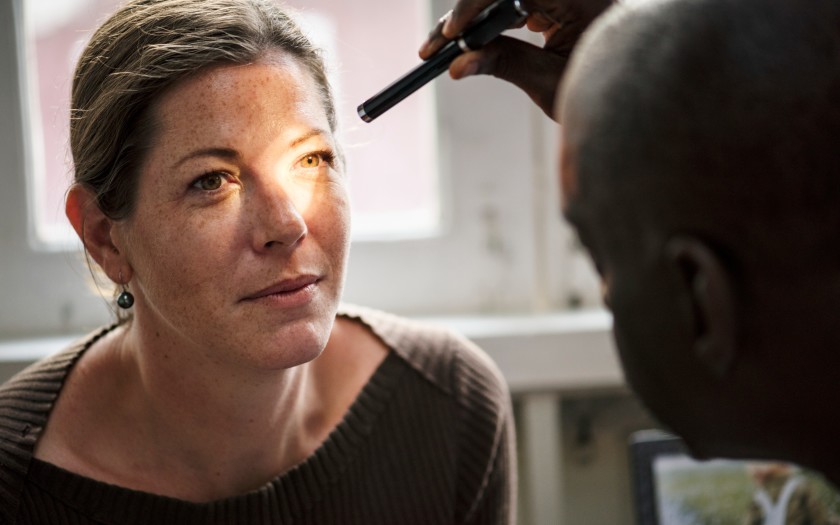Buy one pair of eyeglasses, get a second pair 50% off!
*Restrictions apply. Click here for details.

How to Prevent Snow Blindness
The winter season brings not only scenic snow-covered views and festive ambiance but also the risk of a temporary, yet uncomfortable eye condition known as snow blindness. This condition, which can cause discomfort and potentially impair vision, is primarily a result of ultraviolet (UV) rays reflecting off surfaces such as snow and ice. It's a concern for anyone engaging in outdoor activities during winter without proper eye protection.
If you enjoy winter sports or live in an area with harsh winter conditions, being informed about eye health risks like snow blindness is crucial. In this article, explore the causes, symptoms, and prevention of snow blindness with the experts at Grene Vision Group.
What is Snow Blindness?
Snow blindness, medically named photokeratitis, is similar to a sunburn, but it affects the eyes. It occurs when the eye's cornea, the transparent front surface, is overly exposed to ultraviolet (UV) rays. Snow blindness can develop quickly, particularly in high UV exposure environments, unlike many eye conditions that progress slowly. Though typically temporary, its impact can range from mild discomfort to severe pain and even temporary vision loss.
The cornea is vital for eye protection, but its position and clarity make it vulnerable to UV damage. Intense UV rays can damage or destroy corneal cells, leading to inflammation. This inflammation, a natural healing response, triggers the symptoms associated with snow blindness. Furthermore, the snow's ability to reflect up to 80% of UV rays significantly increases the risk of UV exposure to the eyes in winter.
Snow Blindness Symptoms
Snow blindness, while temporary, can cause significant discomfort and disrupt daily life. Common symptoms include:
Pain or Discomfort: Usually the first indication of snow blindness, the pain can range from mild irritation to intense burning, resembling the feeling of sand in the eyes.
Eye Redness and Swelling: Natural responses to UV damage include redness and swelling, which usually subside as the cornea heals.
Blurred Vision: Damage from UV rays can affect the cornea, leading to blurred vision.
Tearing or Wateriness: Excessive tearing or watery eyes are typical responses to snow blindness, as the eyes try to remove irritants.
Temporary Vision Loss: In extreme cases, snow blindness can cause temporary vision loss, which typically resolves as the condition improves.
Who is At Risk for Photokeratitis?
Snow blindness primarily stems from UV rays reflecting off snow. This reflection can be misleading, occurring even on cloudy days or in shaded areas. Altitude also influences snow blindness risk, as UV radiation intensifies at higher elevations, and the thinner atmosphere provides less protection.
The condition poses a risk to anyone engaged in outdoor winter activities. Outdoor sports enthusiasts like skiers, snowboarders, and mountain hikers face a heightened risk due to prolonged exposure to high UV levels, especially at higher altitudes.
Yet, the risk isn't limited to winter sports fans. Those living in areas with long winter seasons, at high altitudes, or in highly reflective environments like snow-covered regions are also more prone to snow blindness. The combination of bright reflections and thinner air at higher elevations increases the risk, highlighting the need for precautions during winter.
Preventing Snow Blindness
Protecting your eyes from excessive UV radiation and preventing snow blindness is feasible, even for those at higher risk due to location or activities.
Sunglasses and Goggles: Wear sunglasses or goggles with 100% UV protection as your primary defense against snow blindness. They also reduce glare from snow and ice. For activities like skiing, opt for wraparound styles for better UV protection from all angles.
Limiting Exposure: Regular breaks in shaded areas are essential if you live or work in reflective environments, to limit UV exposure.
Hats or Caps: A hat with a brim is a simple addition to your winter gear that can reduce UV ray exposure to your eyes.
Environmental Awareness: Be mindful of spending time in highly reflective environments, like snow-covered areas or high-altitude regions.
The most important preventative measure is to always wear UV-protective eyewear when outside in winter, ensuring your eyes are shielded from harmful UV rays and snow blindness.
Seek Treatment for Snow Blindness at Grene Vision Group
If symptoms of snow blindness persist for more than 24-48 hours, your vision significantly worsens, or you experience severe pain, seek immediate medical attention at Grene Vision Group. Our optometrists can provide medicated eye drops to manage symptoms and arrange follow-up appointments for close monitoring of your recovery. With prompt treatment, most patients recover fully within a few days.
As the winter season approaches, schedule an eye exam at Grene Vision Group to ensure your eyes are ready for the increased UV exposure of winter.

 316-636-2010
316-636-2010 316-609-2177
316-609-2177